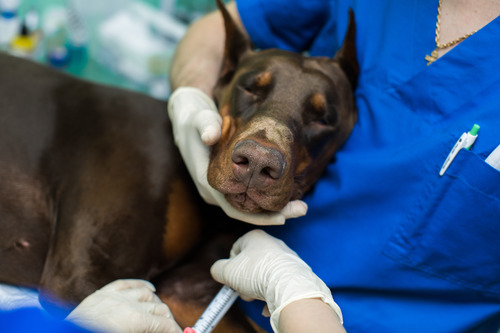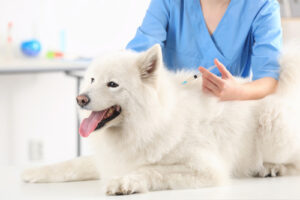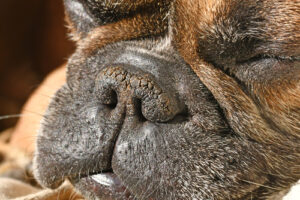Dog anesthesia is a common concern among pet owners, especially when their furry friend needs surgery or a diagnostic procedure. Understanding dog anesthesia, its safety, and how veterinarians use it to ensure the well-being of pets can help alleviate many worries. This blog will dive into the details of dog anesthesia, discussing its safety, the types used, and what to expect when your dog undergoes a procedure involving anesthesia. At World of Animals Veterinary Hospital, we prioritize your dog’s health and comfort, ensuring the best care possible. Contact us today to schedule an appointment and learn more about how we use dog anesthesia safely and effectively.
What Is Dog Anesthesia?
Dog anesthesia is a controlled state of unconsciousness used during surgeries and other medical procedures to prevent pain and stress for the animal. Similar to human anesthesia, it allows veterinarians to perform procedures without causing discomfort to the dog. The process involves administering drugs that induce a temporary loss of sensation and awareness, ensuring the dog remains still and pain-free during the procedure.
Types of Dog Anesthesia
There are several types of anesthesia used in veterinary medicine, each serving different purposes and varying in duration and depth of sedation. The main types include:
General Anesthesia
General anesthesia renders the dog completely unconscious and immobile, often used for major surgeries or invasive procedures. It involves a combination of injectable and inhalant drugs to maintain a deep level of sedation.
Local Anesthesia
Local anesthesia numbs a specific area of the body, allowing the dog to remain awake while preventing pain in the targeted region. This type is commonly used for minor procedures such as wound stitching or dental work.
Sedation
Sedation is a lighter form of anesthesia that calms and relaxes the dog without fully rendering it unconscious. It’s often used for diagnostic imaging, minor surgeries, or procedures where complete immobility is not required.
Is Dog Anesthesia Safe?
Safety is a top concern for pet owners when it comes to dog anesthesia. Veterinary medicine has made significant advancements in anesthesia safety, and modern practices ensure that the risks are minimal. However, as with any medical procedure, there are inherent risks that veterinarians work diligently to mitigate.
Pre-Anesthetic Evaluation
Before administering anesthesia, veterinarians conduct a thorough pre-anesthetic evaluation. This assessment includes a physical examination, blood tests, and sometimes imaging studies to determine the dog’s overall health. Identifying any underlying conditions that might affect the anesthesia process is crucial for minimizing risks.
Monitoring During Anesthesia
Continuous monitoring is a critical aspect of ensuring the safety of dog anesthesia. During the procedure, veterinarians and veterinary technicians use advanced monitoring equipment to track vital signs such as heart rate, respiratory rate, blood pressure, and oxygen levels. This constant vigilance helps detect any abnormalities early, allowing for immediate intervention if necessary.
Post-Anesthetic Care
After the procedure, dogs receive post-anesthetic care to ensure a smooth and safe recovery. This care includes monitoring until the dog is fully awake, managing any pain, and providing a comfortable environment. Veterinarians also provide guidelines for home care to ensure the dog continues to recover well after leaving the clinic.
Common Concerns and Side Effects
Understanding the potential side effects and how veterinarians manage them can help pet owners feel more at ease about dog anesthesia.
Short-Term Side Effects
Most dogs experience mild, short-term side effects following anesthesia, which may include:
- Drowsiness
- Disorientation
- Nausea or vomiting
- Shivering
These effects typically subside within a few hours as the anesthesia wears off.
Long-Term Risks
Long-term complications from dog anesthesia are rare, especially with modern veterinary practices. However, certain dogs, particularly older or those with pre-existing health conditions, may have a slightly higher risk of complications. Discussing these risks with your veterinarian beforehand can help you make informed decisions.
Managing Risks
Veterinarians take several measures to manage and mitigate the risks associated with dog anesthesia. These measures include adjusting anesthetic protocols based on the dog’s health status, using the safest drugs available, and ensuring thorough pre- and post-anesthetic evaluations.
How to Prepare Your Dog for Anesthesia
Proper preparation can help ensure the safest experience for your dog undergoing anesthesia.
Pre-Anesthetic Instructions
Veterinarians often provide specific pre-anesthetic instructions, which may include:
- Fasting: Dogs are typically required to fast for several hours before anesthesia to reduce the risk of aspiration.
- Medication Adjustments: If your dog is on medication, the veterinarian will advise on any adjustments needed before the procedure.
Home Environment
Creating a calm and stress-free environment at home before and after the procedure can help your dog recover more comfortably. Ensure your dog has a quiet, comfortable place to rest and follow any additional care instructions provided by your veterinarian.
When to Contact Your Veterinarian
Knowing when to contact your veterinarian is crucial for your dog’s health, especially after anesthesia.
Post-Procedure Concerns
If your dog shows any unusual symptoms or if the side effects persist beyond a few hours, it’s important to reach out to your veterinarian. Signs to watch for include:
- Persistent vomiting or diarrhea
- Excessive lethargy or difficulty waking up
- Unusual behavior or signs of pain
Routine Follow-Up
Routine follow-up appointments allow veterinarians to monitor your dog’s recovery and address any concerns. These visits are an opportunity to discuss any lingering side effects and ensure your dog is healing properly.
Contact World of Animals Veterinary Hospital Today
Dog anesthesia is a safe and effective way to ensure your pet receives necessary medical care without pain or stress. Understanding the types of anesthesia, the safety measures in place, and how to prepare your dog can help you feel more confident about the process. At World of Animals Veterinary Hospital, we are dedicated to providing the best care for your pet. Contact us today to schedule an appointment and learn more about how we use dog anesthesia to keep your pet healthy and comfortable.





